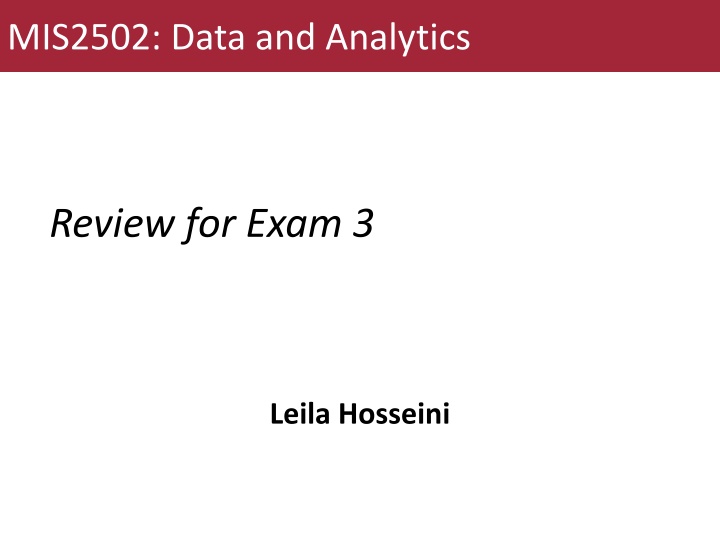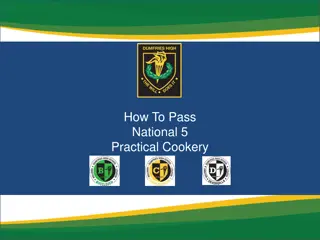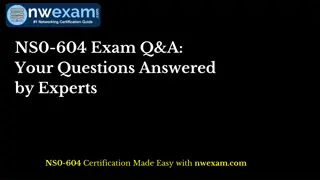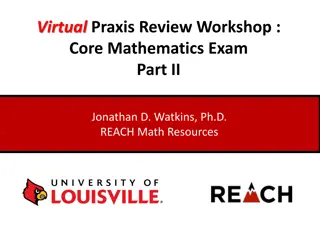
Data Mining and Analytics Exam 3: Review and Study Guide
Prepare for MIS2502 Exam 3 on Data Mining and Analytics with this review covering topics such as Data Mining Techniques, Python Usage, Decision Trees, Cluster Analysis, and Association Rules. Find out when to use Decision Trees, Clustering, and Association Rules, and learn the basics of using Python for data analysis. Get ready for multiple-choice and short-answer questions on Thursday, April 27th.
Download Presentation

Please find below an Image/Link to download the presentation.
The content on the website is provided AS IS for your information and personal use only. It may not be sold, licensed, or shared on other websites without obtaining consent from the author. If you encounter any issues during the download, it is possible that the publisher has removed the file from their server.
You are allowed to download the files provided on this website for personal or commercial use, subject to the condition that they are used lawfully. All files are the property of their respective owners.
The content on the website is provided AS IS for your information and personal use only. It may not be sold, licensed, or shared on other websites without obtaining consent from the author.
E N D
Presentation Transcript
MIS2502: Data and Analytics Review for Exam 3 Leila Hosseini
Overview Date/Time: Thursday, April 27, 9:30 am 10:50 am (80 minutes) Multiple-choice and short-answer questions Closed-book, closed-note Please bring your calculator
Coverage Check the Exam 3 Study Guide 1. Data Mining and Data Analytics Techniques 2. Using Python and Jupyter 3. Decision Tree Analysis 4. Cluster Analysis 5. Association Rules Not every item on this list may be on the exam, and there may be items on the exam not on this list.
Study Materials Lecture slides In-class activities Assignments
How data mining differs from other analysis Data mining can tell you why it is happening, and help predict what will happen Simple analysis tells you what is happening, or what has happened Whatever can be done using SQL, Pivot table and Tableau Prep is not data mining Sum, average, min, max, time trend Decision Trees Clustering Association Rules
When to use which analysis? (Decision Trees, Clustering, and Association Rules) When someone gets an A in this class, what other classes do they get an A in? What predicts whether a company will go bankrupt? If someone upgrades to an iPhone, do they also buy a new case? Which presidential candidate will win the election? Can we group our website visitors into types based on their online behaviors? Can we identify different product markets based on customer demographics? Association Rules Decision Trees Association Rules Decision Trees Clustering Clustering
Using Python The role of packages in Python Basic syntax for Python, for example: Variable assignment Identify functions versus variables Identify how to access a variable (column) from a dataset (table)
Decision Tree Analysis Outcome variable: Discrete/Categorical Interpreting decision tree output Probability of purchase? Who are most/least likely to buy?
Decision Tree Analysis What are the pros and cons with a complex tree? Pros: Better accuracy Cons: hard to interpret, overfitting How would minimum split affect the tree? MINIMUMSPLIT: the minimum number of observations that must exist in a node in order for a split to be attempted Smaller MINIMUMSPLIT more complex tree
Classification Accuracy Predicted outcome: 0 1 0 1001 45 Observed outcome: 1 190 3764 Total: 5000 Error rate? Correct classification rate? (1-0.047) = 0.953 (95.3%) (190+45) /5000= 0.047 (4.7%)
Cluster Analysis Interpret output from a cluster analysis
Cohesion and Separation Cohesion Higher withinss = Lower cohesion (BAD) High withinss means that elements within cluster are far away from each other Separation Higher betweenss = Higher separation(GOOD) High betweenss means that different clusters are far away from each other What happens to those statistics as the number of clusters increases? Higher cohesion (Good) Lower separation (Bad)
Cohesion and Separation Interpret withinss (cohesion) and betweensss (separation) withinss error (cohesion) total betweensss error average betweensss error (separation)
Standardized (Normalized) Data Interpret standardized cluster means for each input variable For standardized values, 0 is the average value for that variable. For Cluster 5: average RegionDensityPercentile >0 higher than the population average average MedianHouseholdIncome, and AverageHouseholdSize <0 lower than the population average
Association Rules Interpret the output from an association rule analysis Compute support count (?), support (s), confidence, and lift c X Y =s X Y s(X) These two formulas will be provided ( ) s X Y = ( ) Lift X Y ( ) * ( ) s X s Y But you need to know how to compute support
Compute Support, confidence, and lift Basket 1 2 3 4 5 6 7 8 Items Coke, Pop-Tarts, Donuts Cheerios, Coke, Donuts, Napkins Waffles, Cheerios, Coke, Napkins Bread, Milk, Coke, Napkins Coffee, Bread, Waffles Coke, Bread, Pop-Tarts Milk, Waffles, Pop-Tarts Coke, Pop-Tarts, Donuts, Napkins Rule Support Confidence Lift {Coke} {Donuts} {Coke, Pop-Tarts} {Donuts}
Compute Support, confidence, and lift Basket 1 2 3 4 5 6 7 8 Items Coke, Pop-Tarts, Donuts Cheerios, Coke, Donuts, Napkins Waffles, Cheerios, Coke, Napkins Bread, Milk, Coke, Napkins Coffee, Bread, Waffles Coke, Bread, Pop-Tarts Milk, Waffles, Pop-Tarts Coke, Pop-Tarts, Donuts, Napkins Rule Support Confidence Lift 0.375 {Coke} {Donuts} 3/8 = 0.375 3/6 = 0.50 0.75 0.375= ?.?? {Coke, Pop-Tarts} {Donuts}
Compute Support, confidence, and lift Basket 1 2 3 4 5 6 7 8 Items Coke, Pop-Tarts, Donuts Cheerios, Coke, Donuts, Napkins Waffles, Cheerios, Coke, Napkins Bread, Milk, Coke, Napkins Coffee, Bread, Waffles Coke, Bread, Pop-Tarts Milk, Waffles, Pop-Tarts Coke, Pop-Tarts, Donuts, Napkins Rule Support Confidence Lift 0.375 {Coke} {Donuts} 3/8 = 0.375 3/6 = 0.50 0.75 0.375= ?.?? 0.25 0.375 0.375= ?.?? {Coke, Pop-Tarts} {Donuts} 2/8 = 0.25 2/3 = 0.67
Compute Support, confidence, and lift Basket 1 2 3 4 5 6 7 8 Items Coke, Pop-Tarts, Donuts Cheerios, Coke, Donuts, Napkins Waffles, Cheerios, Coke, Napkins Bread, Milk, Coke, Napkins Coffee, Bread, Waffles Coke, Bread, Pop-Tarts Milk, Waffles, Pop-Tarts Coke, Pop-Tarts, Donuts, Napkins Rule Support Confidence Lift 0.375 {Coke} {Donuts} 3/8 = 0.375 3/6 = 0.50 0.75 0.375= ?.?? 0.25 0.375 0.375= ?.?? {Coke, Pop-Tarts} {Donuts} 2/8 = 0.25 2/3 = 0.67 Which rule has the stronger association? {Coke, Pop-Tarts} {Donuts} has both higher lift and confidence Consider: (1) a customer with coke in the shopping cart. (2) a customer with coke and pop-tarts in the shopping cart. Who do you think is more likely to buy donuts? The second one, with a higher lift
Compute Support, confidence, and lift Krusty-O s No Yes No 5000 1000 Yes 4000 500 Potato Chips Total: 10500 What is the lift for the rule {Potato Chips} {Krusty-O s}? Are people who bought Potato Chips more likely than chance to buy Krusty-O s too?
Compute Support, confidence, and lift Krusty-O s No Yes No 5000 1000 Yes 4000 500 Potato Chips Total: 10500 What is the lift for the rule {Potato Chips} {Krusty-O s}? Are people who bought Potato Chips more likely than chance to buy Krusty-O s too? ?(?????? ?????,???????? ? ?????? ????? ?(???????? 0.048 0.429 0.143= 0.782 They appear in the same basket less often than what you d expect by chance (i.e., Lift < 1). ???? = =
Association Rules What does Lift > 1 mean? Would you take action on such a rule? The occurrence of X Y together is more likely than what you would expect by random chance (positive association) What about Lift < 1? The occurrence of X would expect by random chance (negative association) Y together is less likely than what you What about Lift = 1? The occurrence of X (no apparent association. X and Y are independent of each other) Y together is the same as random chance
Association Rules Can you have high confidence and low lift? A numeric demonstration: Suppose we have 10 baskets. X appears in 8 baskets. Y appears in 8 baskets. X and Y co- appear in 6 baskets ? ? = 8 ? ? = 0.8 ? ? = 8 ? ? = 0.8 ? ? ? = 6 ? ? ? = 0.6 ?????????? =? ? ? ? ? ? ? ? ? ? ?(? = When both X and Y are popular, you d almost expect them to show up in the same baskets by chance ! When both X and Y are popular . =6 8= 0.75 0.6 0.8 0.8= 0.9375 < 1 You get high confidence ???? = But low lift






















